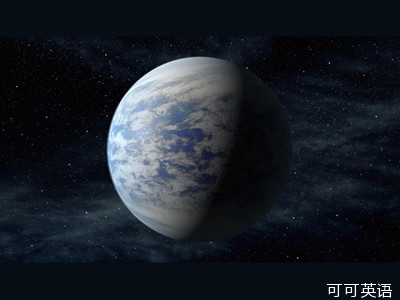The search for habitable, Earth-like planets keeps turning up promising candidates. And although astronomers have yet to find an Earth twin, some newly discovered worlds are pretty interesting in their own right.
人類在尋找像地球一樣適合居住的星球,期間不斷出現有希望的候選人。盡管宇航員們還沒有發現與地球一模一樣的星球,但那些新發現的世界卻在引發他們的關注。

NASA's Kepler space telescope recently spotted seven new exoplanets, three of them in or near their stars' so-called habitable zones. That's the temperate region where a planet could accommodate liquid water. But all three worlds are bigger than Earth, and their composition is uncertain. They could be rocky like Earth or water worlds without landmasses. The discoveries are in the journal Science and in the Astrophysical Journal.
近來,美航局的開普勒太空望遠鏡發現了7顆新的系外行星,其中有三個位于或靠近所謂的“適居帶”。適居帶屬于溫帶地區,那里可以容納液態水。但這三個星球比地球體積要大,組成成分也未知。它們可能跟地球一樣多巖石,也可能是沒有陸地的水世界。這項發現刊登在《科學》雜志和《天體物理學雜志》上。
The planet Kepler 69c follows a Venus-like orbit around a sunlike star. Kepler 69c could be habitable, or it could be a bit too hot, depending on how much starlight the planet absorbs.
開普勒69c圍繞一顆類太陽恒星運轉,其軌道類似于金星圍繞太陽公轉的軌道。開普勒69c可能適于生存,也許它的溫度偏高,但這要取決于它接收多少光照。
Kepler 62e and 62f are smaller, and orbit a star smaller than the sun. One planet receives about 60 percent less radiation than warms Earth, and the other gets about 20 percent more. It's possible that those attributes render Kepler 62e or 62f habitable, but astronomers don't yet know whether they are too cold, too hot or just right.
開普勒62e和開普勒62f體積較小,它們圍繞著一顆比太陽小的恒星公轉。其中一顆行星比地球接收的熱輻射要少60%,另一個則多20%。這樣的條件可能會阻礙開普勒62e和開普勒62f成為適于居住的星球,然而宇航員目前還不確定它們的溫度是太低、太高還是正合適。












